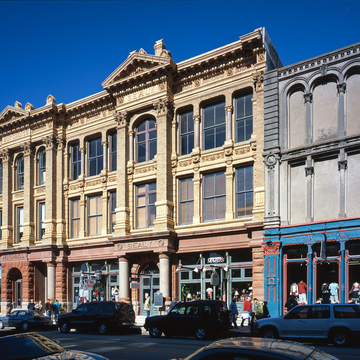Clayton displayed the virtuosity that made him Texas's preeminent late-nineteenth-century architect in designing this pair of three-story buildings—the narrow Ball, Hutchings and Company bank building on the corner and the wider John Sealy Office Building next door—to look like a single building. Clayton made the transition from picturesque renditions of medieval architectural genres to the more up-to-date classical style without losing his sense of buoyancy. He asserted monumentality not with symmetrical composition but sculptural depth, notable in the inset of the upper-floor windows, and a masterful use of materials. Gray and pink granites, with contrasting polished and rough finishes, are combined with red sandstone, tawny brick, and cream terra-cotta ornament.
The Hutchings-Sealy Building was rehabilitated for Cynthia and George P. Mitchell. Mitchell, a Galveston native whose oil business was based in Houston, raised the preservation movement along the Strand, begun by the Galveston Historical Foundation under the direction of Peter H. Brink in the mid-1970s, to a national level of recognition. Not only did he and his wife buy and rehabilitate vacant buildings, Mitchell devised a strategy for economically sustaining these buildings by transforming Strand and adjacent streets into the equivalent of a festival marketplace.







